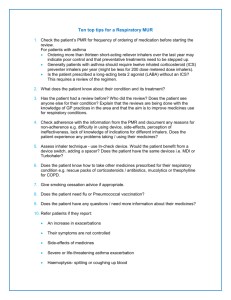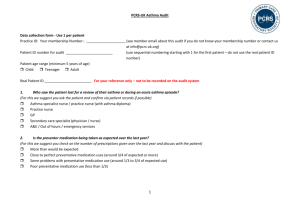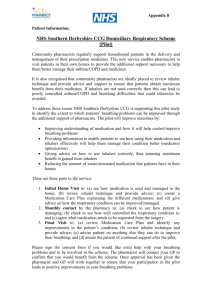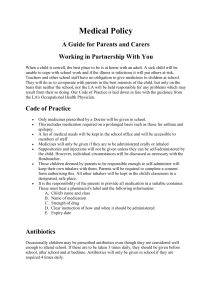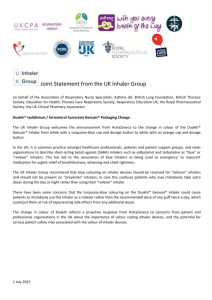6302-e-Draft_question_and_answer_sheet
advertisement
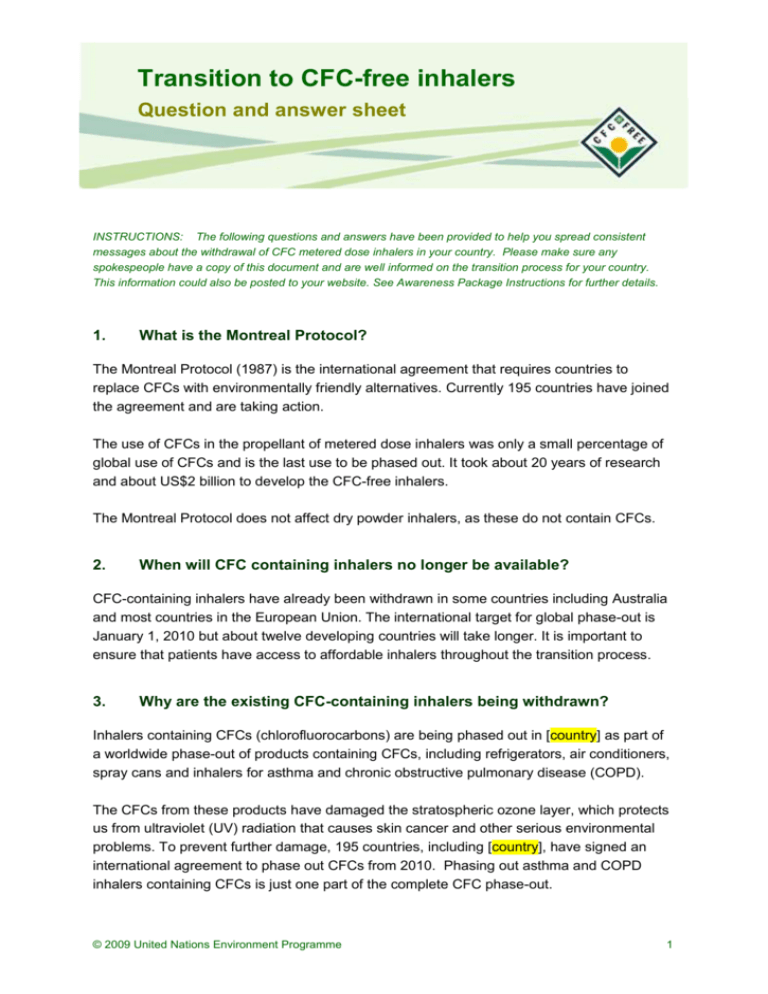
Transition to CFC-free inhalers Question and answer sheet INSTRUCTIONS: The following questions and answers have been provided to help you spread consistent messages about the withdrawal of CFC metered dose inhalers in your country. Please make sure any spokespeople have a copy of this document and are well informed on the transition process for your country. This information could also be posted to your website. See Awareness Package Instructions for further details. 1. What is the Montreal Protocol? The Montreal Protocol (1987) is the international agreement that requires countries to replace CFCs with environmentally friendly alternatives. Currently 195 countries have joined the agreement and are taking action. The use of CFCs in the propellant of metered dose inhalers was only a small percentage of global use of CFCs and is the last use to be phased out. It took about 20 years of research and about US$2 billion to develop the CFC-free inhalers. The Montreal Protocol does not affect dry powder inhalers, as these do not contain CFCs. 2. When will CFC containing inhalers no longer be available? CFC-containing inhalers have already been withdrawn in some countries including Australia and most countries in the European Union. The international target for global phase-out is January 1, 2010 but about twelve developing countries will take longer. It is important to ensure that patients have access to affordable inhalers throughout the transition process. 3. Why are the existing CFC-containing inhalers being withdrawn? Inhalers containing CFCs (chlorofluorocarbons) are being phased out in [country] as part of a worldwide phase-out of products containing CFCs, including refrigerators, air conditioners, spray cans and inhalers for asthma and chronic obstructive pulmonary disease (COPD). The CFCs from these products have damaged the stratospheric ozone layer, which protects us from ultraviolet (UV) radiation that causes skin cancer and other serious environmental problems. To prevent further damage, 195 countries, including [country], have signed an international agreement to phase out CFCs from 2010. Phasing out asthma and COPD inhalers containing CFCs is just one part of the complete CFC phase-out. © 2009 United Nations Environment Programme 1 Question and answer sheet 4. What propellant is used by the new CFC-free inhalers? The new CFC-free inhalers use hydrofluoroalkanes (HFAs) as the propellant. These HFAs deliver exactly the same medicine as the CFC-containing inhalers, they are safe to use and do not affect the ozone layer. 5. What medications will be available to people with asthma and COPD after the withdrawal date? From 2010, all asthma and COPD inhalers in [country] will be either dry powder (which is already extensively used) or using a new hydrofluoroalkane (HFA) propellant. HFA inhalers are already available in many countries. They may be more expensive than older inhalers. These inhalers will provide people with exactly the same medicine that they are used to, delivering the same health benefits, without damaging the ozone layer. 6. How can you be sure that these new medications will be as effective as the CFC containing inhalers? Extensive clinical trials have been undertaken to determine the safety and effectiveness of the new CFC-free metered dose inhalers compared with the older CFC-containing versions. The hydrofluoroalkane (HFA) inhalers have been found to be as safe and effective as the CFC-containing inhalers as well as providing a number of additional benefits. For example, research has shown that the HFA propellant solutions can penetrate the small airways in the lung better than the older CFC propellants of the same medicine1. Some new metered-dose inhalers produce particles that travel more slowly than the CFC-containing inhalers, which can make it easier for patients to inhale at the right time when activating the inhaler. Some CFC-free inhalers have a warmer and less forceful spray, so it may reduce the risk of patients holding their breath, which can happen when they feel a cold spray2. 7. There have been reports that the medicine in the new HFA inhalers sounds, feels, tastes or smells different from the medicine in the CFC containing inhalers – is it different? The only thing that has changed is the device delivering the medication – nothing else has changed. Some people may notice that the spray sounds, feels, tastes or smells different from their old inhaler. But the new inhalers contain exactly the same medicine as the CFCcontaining inhalers and they are just as effective. 1 Zeidler M. Corren J. Hydrofluroalkane formulations of inhaled corticosteroids for the treatment of asthma. Treat Respire Med 2004; 3: 35-44. 2 Leach CL. The CFC to HFA transition and its impact on pulmonary drug development. Respir Care 2005; 50: 1201-8. 2 © 2009 United Nations Environment Programme Question and answer sheet 8. Some people may be concerned that some of the new propellants are alcohol-based – how can these people continue to manage their asthma or COPD? Some hydrofluoroalkane (HFA) inhalers contain very small amounts of alcohol in the propellant. This may concern people who avoid alcohol for religious or other reasons. The amount of alcohol per dose (puff) is extremely small and is unlikely to affect your health. It is needed to make the inhaler work effectively. The use of medicines that contain alcohol is commonly permitted by many religious authorities. You may wish to consult your own religious institution for confirmation. Anyone with asthma or COPD concerned about the alcohol content of some HFA inhalers should ask their doctor to prescribe an appropriate medication and should continue to manage their condition in line with their doctor’s recommendations. Dry powder inhalers, which have been available in [country] for many years, will continue to provide an alcohol-free option. 9. What advice do you have for people with asthma and COPD who are currently using CFC-containing inhalers? Now is the time to visit your doctor to review your asthma or COPD treatment plan and familiarise yourself with the CFC-free inhalers. Your doctor or nurse will be able to show you how to use, clean and care for your CFC-free inhaler. You may be prescribed a dry powder inhaler instead of a CFC-free version of your old inhaler. These dry powder inhalers work differently and do not contain any CFCs. 10. What information is available to people who will be affected by this change? Informational materials have been developed to help health professionals and patients move to the new CFC-free asthma and COPD inhalers. Resources include an information paper for health professionals detailing the scientific basis for the efficacy and safety of the CFC-free inhalers and a patient information brochure explaining the changes for people with asthma and COPD. Copies of the resources are available from [insert details]. © 2009 United Nations Environment Programme 3
